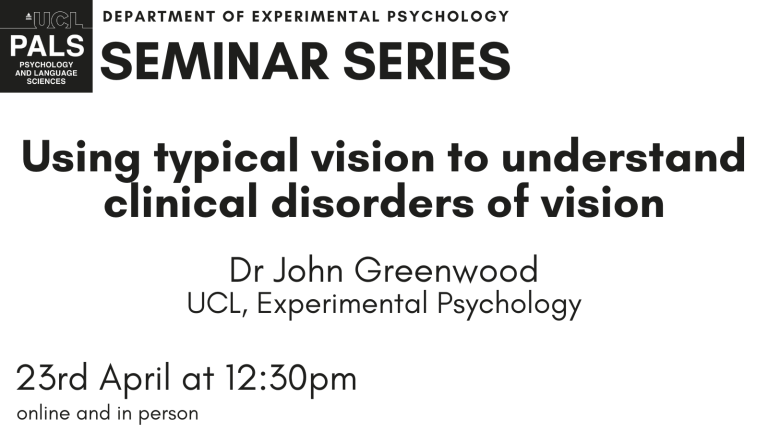Experimental Psychology Seminar - John Greenwood, UCL
23 April 2024–24 April 2024, 12:30 pm–3:00 pm

John Greenwood will present research demonstrating how crowding—where clutter merges visual elements—affects both peripheral and foveal vision. His studies illustrate similar error patterns in the typical vision and in conditions like amblyopia, suggesting that these effects are governed by 'pooling' models. These models propose that crowding simplifies visual scenes into a general 'gist', reducing the demand on neural resources. This research extends to how crowding independently affects color and motion judgments, offering insights into the visual system's multifaceted response to clutter.
Event Information
Open to
- All
Organiser
-
Antonietta Esposito
Location
-
31385: 26 Bedford Way26 Bedford WayLondonWC1H 0DSUnited Kingdom
Venue: Room 313, 26 Bedford Way.
A buffet lunch will be available just before the talk at 12.30pm in room 313BW.
You may also attend virtually via zoom:
https://ucl.zoom.us/j/91768876812?pwd=aExJVmFTZnBZZCtFbmlGS0tSY2VCdz09
Meeting ID: 917 6887 6812
Passcode: 950231
Title:
Using typical vision to understand clinical disorders of vision
Abstract:
Our ability to recognise objects in the world is impaired in cluttered environments, even for objects that are clearly visible in isolation. This process, known as crowding, presents the fundamental limit on our peripheral vision. These disruptive effects are elevated in foveal vision (the centre of our gaze) during development, and further elevated in clinical disorders including amblyopia (‘lazy eye’) and nystagmus (uncontrolled eye movements), placing a limit on everyday tasks like reading.
Can we understand the mechanisms underlying these elevations using crowding in the typical periphery? I will first show that crowding produces the same kinds of errors in peripheral vision as in the foveal vision of typical and amblyopic children. These errors are well described in all cases by ‘pooling’ models that depict crowding as an unwanted combination of cluttered elements. In peripheral vision, crowding can also independently disrupt judgements of colour and motion for the same target object, suggesting the existence of multiple instances of crowding throughout the visual system. Dissociations between the crowding of colour and motion are similarly evident in amblyopic vision. Together, our findings depict crowding as a process that simplifies the visual scene to provide a ‘gist’ that can be efficiently encoded with reduced neural resources.
About the Speaker
John Greenwood
Associate Professor in Experimental Psychology at Experimental Psychology, UCL
I am Associate Professor in Experimental Psychology at University College London, working on visual perception. My lab examines spatial vision and 'crowding' in both typical peripheral vision and in clinical disorders such as amblyopia and nystagmus, as well as face recognition, visual imagery and hallucinations, and the perception of visual dimensions including motion, depth, and position. I joined the department in 2013 with a Career Development Award from the Medical Research Council, having previously undertaken postdoctoral research at the Institute of Ophthalmology at University College London (London, UK) with Prof. Steven Dakin and Dr. Peter Bex from 2008-2010, and at the Laboratoire Psychologie de la Perception of the Université Paris Descartes (Paris, France) with Patrick Cavanagh from 2011-2013. My Ph.D. was completed in 2007 at the School of Psychology of the Australian National University (Canberra, Australia), with Dr. Mark Edwards.
More about John Greenwood Close
Close

